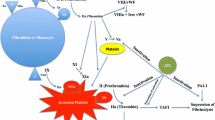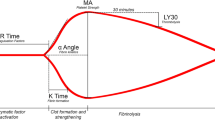Abstract
Background
Approximately one-third of patients with isolated traumatic brain injury (iTBI) present with acute traumatic coagulopathy (ATC). ATC is associated with increased morbidity and mortality. Its effects on long-term functional and cognitive outcomes are not as well characterized.
Methods
Data from the Citicoline Brain Injury Treatment Trial (COBRIT) were analyzed retrospectively. Exclusion criteria were renal failure or malignancy, and any extracranial injury severity score >3. ATC was defined as INR > 1.3, PTT > 38 s, or platelets < 100 K, determined at baseline, and during the first 7 days of hospitalization.
Results
Six hundred forty-seven patients were included; 21 % were found to have ATC. Highest incidence occurred at baseline, and Day Two. Forty-two percent of ATC patients had a GCS < 8, compared with 11.3 % of non-ATC patients (p < 0.001). A significantly higher proportion of ATC patients was transfused blood products, required greater than 4L of fluids, demonstrated hyperthermia and hypothermia, were hypotensive and demonstrated elevated lactate when compared to non-ATC patients. In-hospital mortality, mean hospital length of stay, incidence of DVT and seizures were also significantly higher in ATC patients. A significantly lower portion of ATC patients had good outcomes on the GOS-E (i.e., score > 6), and the DRS (i.e., score < 2) at 180 days, for which ATC was found to be an independent predictor with binary logistic regression. ATC patients also performed significantly worse on several components of the CVLT-II at 180 days.
Conclusions
ATC accompanying iTBI is associated with worse functional and cognitive outcomes at 180 days.


Similar content being viewed by others
References
Pringsheim T, Fiest K, Jette N. Global perspectives: the international incidence and prevalence of neurologic conditions: how common are they ? Neurology. 2014;83:1661–5.
Bazarian JJ, Cernak I, Noble-Haeusslein L, Potolicchio S, Temkin N. Long-term neurologic outcomes after traumatic brain injury. J Head Trauma Rehabil. 2009;24:439–51.
Gardner RC, Burke JF, Nettiksimmons J, Kaup A, Barnes DE, Yaffe K. Dementia risk after traumatic brain injury vs nonbrain trauma: the role of age and severity. JAMA Neurol. 2014;94121:1–8.
Keimowitz RM, Annis BL. Disseminated intravascular coagulation associated with massive brain injury. J Neurosurg. 1973;39:178–80.
Vecht C, Sibinga C, Minderhoud J. Disseminated intravascular coagulation and head injury. J Neurol Neurosurg Psychiatry. 1975;38:567–71.
Auer L. Disturbances of the coagulatory system in patients with severe cerebral trauma I. Acta Neurochir (Wien). 1978;43:51–9.
Van der Sande JJ, Veltkamp JJ, Boekhout-Mussert RJ, Bouwhuis-Hoogerwerf ML. Head injury and coagulation disorders. J Neurosurg. 1978;49:357–65.
Harhangi BS, Kompanje EJO, Leebeek FWG. Maas a IR: coagulation disorders after traumatic brain injury. Acta Neurochir (Wien). 2008;150:165–75; discussion 175.
Wafaisade A, Lefering R, Tjardes T, Wutzler S, Simanski C, Paffrath T, et al. Acute coagulopathy in isolated blunt traumatic brain injury. Neurocrit Care. 2010;12:211–9.
Lustenberger T, Talving P, Kobayashi L, Barmparas G, Inaba K, Lam L, et al. Early coagulopathy after isolated severe traumatic brain injury: relationship with hypoperfusion challenged. J Trauma. 2010;69:1410–4.
Franschman G, Greuters S, Jansen WH, Posthuma LM, Peerdeman SM, Wattjes MP, et al. Haemostatic and cranial computed tomography characteristics in patients with acute and delayed coagulopathy after isolated traumatic brain injury. Brain Inj. 2012;26:1464–71.
Greuters S, van den Berg A, Franschman G, Viersen V, Beishuizen A, Peerdeman SM, et al. Acute and delayed mild coagulopathy are related to outcome in patients with isolated traumatic brain injury. Crit Care. 2011;15:R2.
Talving P, Benfield R, Hadjizacharia P, Inaba K, Chan LS, Demetriades D. Coagulopathy in severe traumatic brain injury: a prospective study. J Trauma. 2009;66:55–61; discussion 61–62.
Sun Y, Wang J, Wu X, Xi C, Gai Y, Liu H, et al. Validating the incidence of coagulopathy and disseminated intravascular coagulation in patients with traumatic brain injury-analysis of 242 cases. Br J Neurosurg. 2011;25:363–8.
Kushimoto S, Yamamoto Y, Shibata Y, Sato H, Koido Y. Implications of excessive fibrinolysis and alpha(2)-plasmin inhibitor deficiency in patients with severe head injury. Neurosurgery. 2001;49:1084–9; discussion 1089–90.
Zafonte RD, Bagiella E, Ansel BM, Novack TA, Friedewald WT, Hesdorffer DC, et al. Effect of Citicoline on functional. J Am Med Assoc. 2012;308:1993–2000.
Lustenberger T, Talving P, Kobayashi L, Inaba K, Lam L, Plurad D, et al. Time course of coagulopathy in isolated severe traumatic brain injury. Injury. 2010;41:924–8.
Epstein DS, Mitra B, O’Reilly G, Rosenfeld JV, Cameron PA. Acute traumatic coagulopathy in the setting of isolated traumatic brain injury: a systematic review and meta-analysis. Injury. 2014;45:819–24.
Genét GF, Johansson PI, Meyer MAS, Sølbeck S, Sørensen AM, Larsen CF, et al. Trauma-induced coagulopathy: standard coagulation tests, biomarkers of coagulopathy, and endothelial damage in patients with traumatic brain injury. J Neurotrauma. 2013;30:301–6.
Carrick MM, Tyroch AH, Youens CA, Handley T. Subsequent development of thrombocytopenia and coagulopathy in moderate and severe head injury: support for serial laboratory examination. J Trauma Inj Infect Crit Care. 2005;58:725–30.
Maegele M. Coagulopathy after traumatic brain injury: incidence, pathogenesis, and treatment options. Transfusion. 2013;53(Suppl 1):28S–37S.
Maegele M, Schöchl H, Cohen MJ. An update on the coagulopathy of trauma. Shock. 2014;41(Suppl 1):21–5.
Cohen MJ, Brohi K, Ganter MT, Manley GT, Mackersie RC, Pittet J-F. Early coagulopathy after traumatic brain injury: the role of hypoperfusion and the protein C pathway. J Trauma. 2007;63:1254–61; discussion 1261–62.
Goodnight SH, Kenoyer G, Rapaport SI, Patch MJ, Lee JA, Kurze T. Defibrination after brain-tissue destruction: a serious complication of head injury. N Engl J Med. 1974;290:1043–7.
Stein SC, Smith DH. New perspectives in management of brain injury coagulopathy in traumatic brain injury. Neurocrit Care. 2004;1:479–88.
Drake TA, Morrissey JH, Edgington TS. Selective cellular expression of tissue factor in human tissues. Implications for disorders of hemostasis and thrombosis. Am J Pathol. 1989;134:1087–97.
Huber A, Dorn A, Witzmann A, Cervs-navarro J. Microthrombi formation after severe head trauma. Int J Legal Med. 1993;106:152–5.
Geerts W, Code K, Jay R, Chen E, Szalai J. A prospective study of venous thromboembolism after major trauma. Med: New Engl J; 1994.
Kemp CD, Cotton B, Johnson C, Weaver K. How we die: the impact of non-neurological organ dysfunction following traumatic brain injury. Am Surg. 2008;74:866–72.
Mascia L, Sakr Y, Pasero D, Payen D, Reinhart K, Vincent JL. Extracranial complications in patients with acute brain injury: a post hoc analysis of the SOAP study. Intensive Care Med. 2008;34:720–7.
Piek J, Chesnut RM, Marshall LF, van Berkum-Clark M, Klauber MR, Blunt BA, et al. Extracranial complications of severe head injury. J Neurosurg. 1992;77:901–7.
Dams-O’Connor K, Pretz C, Billah T, Hammond FM, Harrison-Felix C. Global outcome trajectories after TBI among survivors and nonsurvivors. J Head Trauma Rehabil. 2015;30(4):E1–10.
Hall K, Cope D, Rappaport M. Glasgow Outcome Scale and Disability Rating Scale: comparative usefulness in following recovery in traumatic head injury. Arch Phys Med Rehabil. 1985;66:35–7.
Rappaport M, Hall K, Hopkins K, Belleza T, Cope D. Disability rating scale for severe head trauma: coma to community. Arch Phys Med Rehabil. 1982;63:118–23.
Elwood RW. The california verbal learning test: psychometric characteristics and clinical application. Neuropsychol Rev. 1995;5:173–201.
Donders J, Nienhuis J. Utility of California Verbal Learning Test, Second Edition, recall discriminability indices in the evaluation of traumatic brain injury. J Int Neuropsychol Soc. 2007;13:354–8.
DeJong J, Donders J. Cluster subtypes on the California Verbal Learning Test-Second Edition (CVLT-II) in a traumatic brain injury sample. J Clin Exp Neuropsychol. 2010;32:953–60.
Jacobs ML, Donders J. Performance discrepancies on the California Verbal Learning Test: Second Edition (CVLT-II) after traumatic brain injury. Arch Clin Neuropsychol. 2008;23:113–8.
Cristofori I, Levin HS. Traumatic brain injury and cognition. Handb Clin Neurol. 2015;128:579–611.
Winter JP, Plummer D, Bottini A, Rockswold GR, Ray D. Early fresh frozen plasma prophylaxis of abnormal coagulation parameters in the severely head-injured patient is not effective. Ann Emerg Med. 1989;18:553–5.
Etemadrezaie H, Baharvahdat H, Shariati Z, Lari SM, Shakeri MT, Ganjeifar B. The effect of fresh frozen plasma in severe closed head injury. Clin Neurol Neurosurg. 2007;109:166–71.
Hulka F, Mullins RJ, Frank EH. Blunt brain injury activates the coagulation process. Arch Surg. 1996;9:923–7; discussion 927–28.
Bredbacka S, Edner G. Soluble fibrin and d-dimer as detectors of hypercoagulability in patients with isolated brain trauma. J Neurosurg Anesthesiol. 1994;6:75–82.
Epstein DS, Mitra B, Cameron PA, Fitzgerald M, Rosenfeld JV. Acute traumatic coagulopathy in the setting of isolated traumatic brain injury: definition, incidence and outcomes. Br J Neurosurg. 2014;29:118–22.
Talving P, Lustenberger T, Okoye OT, Lam L, Smith JA, Inaba K, et al. The impact of liver cirrhosis on outcomes in trauma patients: a prospective study. J Trauma Acute Care Surg. 2013;75:699–703.
McNamara JJ, Burran EL, Stremple J, Molot MD. Coagulopathy after major combat injury: occurrence, management and pathophysiology. Ann Surg. 1972;176:243–6.
Schöchl H, Solomon C, Traintinger S, Nienaber U, Tacacs-Tolnai A, Windhofer C, et al. Thromboelastometric (ROTEM) findings in patients suffering from isolated severe traumatic brain injury. J Neurotrauma. 2011;28:2033–41.
Nekludov M, Bellander B-M, Blombäck M, Wallen HN. Platelet dysfunction in patients with severe traumatic brain injury. J Neurotrauma. 2007;24:1699–706.
De Oliveira Manoel AL, Neto AC, De Veigas PV, Rizoli S. Traumatic brain injury associated coagulopathy. Neurocrit Care. 2014;22:34–44.
Massaro AM, Doerfler S, Nawalinski K, Michel B, Driscoll N, Ju C, et al. Thromboelastography defines late hypercoagulability after TBI: a pilot study. Neurocrit Care. 2014;22:45–51.
Author information
Authors and Affiliations
Corresponding author
Ethics declarations
Conflict of interest
Drs. Abdelmalik, Tracy and Jallo, as well as Mr. Boorman, have no sources of funding to disclose. Dr. Rincon has received salary and research grant support from the American Heart Association (AHA 12CRP12050342) and Genentech (G-29902). Data used in this study was generated by the investigators in the Clinical Sites and Data Coordinating Center composing the NIH Collaborative Multicenter TBI Clinical Trials Network. This project was funded by the National Institute of Child Health and Human Development of the National Institutes of Health. COBRIT was supported in part by National Institute Award numbers NICHD U01HD042823, U01HD042738, U01HD 042687, U01HD042736, U01HD042678, U01HD042686, U01H D042653, U01HD042689, and U01HD042652, to eight clinical sites and a data coordinating center.
Additional information
A portion of this work was presented at the 67th annual meeting of the American Academy of Neurology, April 18–25, 2015.
Rights and permissions
About this article
Cite this article
Abdelmalik, P.A., Boorman, D.W., Tracy, J. et al. Acute Traumatic Coagulopathy Accompanying Isolated Traumatic Brain Injury is Associated with Worse Long-Term Functional and Cognitive Outcomes. Neurocrit Care 24, 361–370 (2016). https://doi.org/10.1007/s12028-015-0191-0
Published:
Issue Date:
DOI: https://doi.org/10.1007/s12028-015-0191-0




